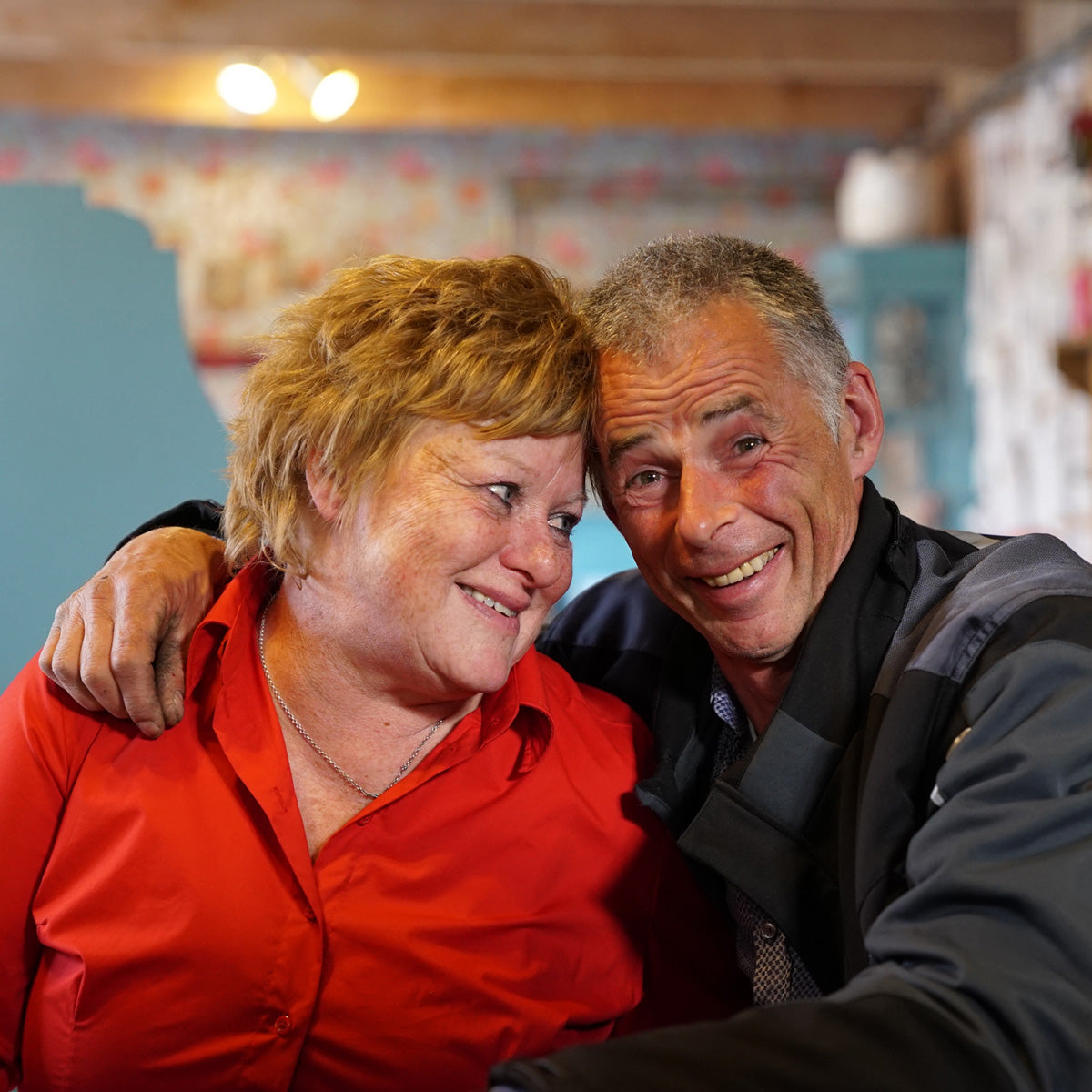Foot massage declined
 Can you believe it? I offered a price of half a euro per bulb plus an additional foot massage for the first crates of Tulip Love Story. Jan Vink, a grower in my neighbourhood, will be selling this phenomenal Tulip this year, and he told me no to my very genuine offer! Shame on him, when I make the offer later this Spring it will be the money only. He did laugh at that, but I have to tell you I was quite relieved. If he’d said yes, I probably would not have touched his feet, but given him one of those walk-on-your-back massages. Also a foot massage, or not? You have to think very carefully about this offer beforehand, though: Jan is a giant of a man. Not just any giant, I think Goliath would have looked small next to him. If he drives his van onto your property, the cat scurries off through his cat flap door, guard dogs run away, and birds fly off. Once he straightens himself to his full height though, you can tell that this man is anything but scary: won’t hurt a fly, and focuses himself purely on growing flowers with his close family members.
Can you believe it? I offered a price of half a euro per bulb plus an additional foot massage for the first crates of Tulip Love Story. Jan Vink, a grower in my neighbourhood, will be selling this phenomenal Tulip this year, and he told me no to my very genuine offer! Shame on him, when I make the offer later this Spring it will be the money only. He did laugh at that, but I have to tell you I was quite relieved. If he’d said yes, I probably would not have touched his feet, but given him one of those walk-on-your-back massages. Also a foot massage, or not? You have to think very carefully about this offer beforehand, though: Jan is a giant of a man. Not just any giant, I think Goliath would have looked small next to him. If he drives his van onto your property, the cat scurries off through his cat flap door, guard dogs run away, and birds fly off. Once he straightens himself to his full height though, you can tell that this man is anything but scary: won’t hurt a fly, and focuses himself purely on growing flowers with his close family members.
 Another Tulip from Jan Vink. A total weirdo, this one. I’m not sure if it’s actually a pretty tulip, but sometimes that is not what you are looking for, so I am glad she exists. Out of her flower, another flower grows.
Another Tulip from Jan Vink. A total weirdo, this one. I’m not sure if it’s actually a pretty tulip, but sometimes that is not what you are looking for, so I am glad she exists. Out of her flower, another flower grows.
So, maybe in the Spring, I’ll be able to buy bulbs from him. I might put up a tent at the end of the field of Love Story’s. I would really like to be able to offer them in our web shop, but as you see I cannot make any promises yet. Jan calls this Tulip a fly-tulip: She grows so tall that she reaches the fly of your trousers. Fly Tulip.
Off track again. I wanted to tell you about Dahlias this week. There was a question from the audience about Dahlias, and I wanted to use this newsletter to answer it for everyone. A nice lady asked us how Dahlias multiplied in number, as their tubers were so different than flower bulbs.
 Dahlia grower Peter Komen’s fields
Dahlia grower Peter Komen’s fields
To give an extensive answer, I had to get in the car to drive to Anna Paulowna, a town nearby. I went over to Peter Komen, a colleague of mine in the flower bulb world. He is as crazy about his Dahlias as I am about my Daffodils, so that will give you an idea about him as a person. You might recognise his name from the Fluwel web store, as many of the Dahlia stories feature him as a guest star in their descriptions. Peter is one of the best Dahlia growers around, and has brought many success stories into the world. Dahlia Night Silence, for example. She was sold out before some people had even had the time to look at the web shop!

Dahlia American Sunset
I won’t be telling you every single variety Peter offers, but I will show you how he grows his seedlings into large parties of bulbs. This starts off on a very small scale, Peter only has one tuber of the new varieties he chooses to continue to develop. In practice, all Dahlia growers do this the same way, whether they are making new varieties or growing a specific one. I’ll show you with some photos. If you are usually good with plants, it is absolutely possible to recreate this process in your own garden, be it with a few small alterations for a smaller scale.
 In the attic of his garage, Peter plants his Dahlias in pots. In a room that stays about 20 degrees Celsius, and under fluorescent lights, they slowly but surely grow. Peter has over 600 pots, and every pot contains a different variety. These tubers were selected by Peter this summer, when he went through his Dahlia seedlings. They are all new varieties, and the only thing we know about them until now is that the flower looked good. We still have to grow them more to see about their other characteristics.
In the attic of his garage, Peter plants his Dahlias in pots. In a room that stays about 20 degrees Celsius, and under fluorescent lights, they slowly but surely grow. Peter has over 600 pots, and every pot contains a different variety. These tubers were selected by Peter this summer, when he went through his Dahlia seedlings. They are all new varieties, and the only thing we know about them until now is that the flower looked good. We still have to grow them more to see about their other characteristics. 
As soon as the tuber develops this bit of green, which is a few centimeters long, it is cut off the main tuber and put into a pot with the number of that seedling.

Before Peter picks another green bit, he disinfects his fingers with antibacterial soap, as otherwise there is a slight chance of transmitting a virus or bacteria to multiple seedlings.

Here, you see Peter stand in front of a tray of seedlings. Every hole contains a different seedling that has just been picked. We aren’t in the attic anymore, this construction is downstairs in the garage, where these small Dahlias are planted. The red lights are from led lights. This is best for the Dahlias to grow in.
 The plant cuttings are in these so-called seed crates. The holes in the crate are filled with rich soil. Then, a small hole is made using a pen or a small stick to put the cutting in. We don’t use the cutting itself to push through the soil: it is too small still, and it might be damaged or break off
The plant cuttings are in these so-called seed crates. The holes in the crate are filled with rich soil. Then, a small hole is made using a pen or a small stick to put the cutting in. We don’t use the cutting itself to push through the soil: it is too small still, and it might be damaged or break off
 The cuttings are also dipped in a special kind of powder that enhances root growth before they are planted
The cuttings are also dipped in a special kind of powder that enhances root growth before they are planted

This is the can of powder used for the cuttings

One by one, the cuttings are planted in their right place. You really have to be a very precise kind of person for this job; you won’t learn anything useful if you plant them at the wrong number. I’ve only seen Peter make one mistake through the whole morning, and as we were with the two of us, I still remembered, so it was saved after all. He might have just been nervous: He’d told me he had to go to the dentist later that day, a good reason to be a little bit distracted if you ask me.

Fun fact about Dahlias is their need for light. Peter told me Dahlias need lamps that are on 14 to 16 hours a day. If you turn them off earlier, Dahlias will start to grow flowers right away. If you turn them off later, the Dahlia will experience stress and their leafs will not know where to turn anymore and shrivel. Dahlias need a night’s sleep of about 8 hours to feel well-rested.

Another fun fact: tomato leafs. If you talk a lot with the Dahlia fanatics, you’ll hear the word ‘tomato leaf’ every now and then. This refers to a Dahlia with a leaf that looks like one a tomato plant might have. Those Dahlias have a leaf that sort of has the shape of a hand with fingers instead of a normal shaped leaf with a serrated edge.
So, how can you do this at home, should you want to? When you receive your Dahlia, you plant her in a pot (like Peter does in the first step) and put it in a warm room in your house, in the windowsill. You’ll quickly see small green parts come up. Pick these small parts and plant them dipped into a bit of root powder before placing them in the pre-made hole in the soil of the very small pot. This little pot needs to go into a slightly cooler room for a week or two. This room should also have a lot of light, at least until she has made a root. If you notice your cutting is growing, you can take her outside to grow further. Now, don’t put her in the full sun: half sun, half shadow will do best. Most important is that she never experiences any frost. These leafs are still very young and will freeze off right away. You have to pay a lot of attention to them; these small pots, with a quickly growing cutting in them, need a lot of water. Feel every day if the soil is dry and water accordingly. You can transfer them to a slightly larger pot if that is easier for you, just make sure that they have a few good roots before you do so. As soon as you are sure there won’t be any more frost at night, you can plant these cuttings into the soil of your garden. Another fun fact is, that if you manage to do it right, you could get 20 cuttings from one tuber! And these cuttings will eventually make as large of a plant as the grown tubers you buy in our webshop. A full garden doesn’t have to cost a lot of money if you are willing to patiently practice your skills: you’ll only need one (or a few) high-quality products to start. If you are going to try it out, I look forward to hearing about your progress. Don’t feel bad if it doesn’t work out the first time: this is people’s professional job, so it’s only logical that you should need a bit of practice.
I’ll stop, I’m way over my word count already. There is one more message left: Renata told me that all orders that we have received until now have been shipped off, so you can expect them probably very soon. Have fun with your Dahlias and other Summer blooming varieties.
Kind regards,
Carlos van der Veek

 Deutsch
Deutsch English
English Nederlands
Nederlands
